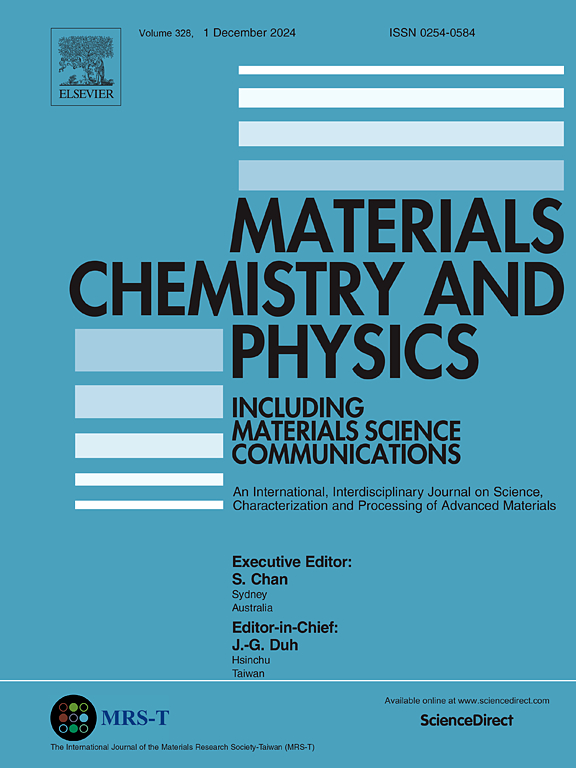Enhanced magnetic hyperthermia of green-synthesized CoFe2O4/C-dots nanocomposites utilizing moringa oleifera extract and watermelon peels
IF 4.3
3区 材料科学
Q2 MATERIALS SCIENCE, MULTIDISCIPLINARY
引用次数: 0
Abstract
This research focuses on cobalt ferrite (CoFe2O4)/carbon dots (C-dots) nanocomposites synthesized through green synthesis, utilizing Moringa oleifera leaf extract and watermelon rind waste for magnetic hyperthermia applications in cancer therapy, enabling targeted and localized heating. CoFe2O4 nanoparticles were synthesized via a co-precipitation method, while the C-dots were produced hydrothermal. Sonication was applied to connect the C-dots to the surface of CoFe2O4. The X-ray diffraction spectrum of CoFe2O4/C-dots shows a cubic spinel structure with crystallite sizes ranging from 7.6 nm to 6.2 nm, where the crystallite size decreases with increasing C-dots concentration. Transmission electron microscopy observations reveal that the size of the nanocomposites is almost consistent at around 11.8–12.1 nm. The Co–O and Fe–O functional groups detected in the nanocomposite indicate that CoFe2O4 remains after fabrication. The identified C–O, C![]() C, and O–H groups also confirm the presence of C-dots on the CoFe2O4 surface. The UV–Vis absorption spectrum peaks at 282 nm for C-dots and 218 nm for CoFe2O4. The addition of C-dots affects the saturation magnetization and domain size, which are 55–56.4 emu/g and 3.2–3.5 nm, indicating good magnetic properties. Additionally, the specific absorption rate (SAR) value of CoFe2O4/C-dots depends on magnetization, with the SAR value decreasing with increasing C-dots concentration while increasing with higher frequency and alternating magnetic field. The highest SAR values for CoFe2O4 and CoFe2O4/C-dots are 626 mW/g and 485 mW/g, respectively, which decrease with an increase in C-dots concentration. These results indicate that CoFe2O4/C-dots synthesized using green methods are promising candidates that can optimize performance in magnetic hyperthermia applications in the future.
C, and O–H groups also confirm the presence of C-dots on the CoFe2O4 surface. The UV–Vis absorption spectrum peaks at 282 nm for C-dots and 218 nm for CoFe2O4. The addition of C-dots affects the saturation magnetization and domain size, which are 55–56.4 emu/g and 3.2–3.5 nm, indicating good magnetic properties. Additionally, the specific absorption rate (SAR) value of CoFe2O4/C-dots depends on magnetization, with the SAR value decreasing with increasing C-dots concentration while increasing with higher frequency and alternating magnetic field. The highest SAR values for CoFe2O4 and CoFe2O4/C-dots are 626 mW/g and 485 mW/g, respectively, which decrease with an increase in C-dots concentration. These results indicate that CoFe2O4/C-dots synthesized using green methods are promising candidates that can optimize performance in magnetic hyperthermia applications in the future.
利用辣木提取物和西瓜皮绿色合成CoFe2O4/C-dots纳米复合材料的增强磁热疗
本研究主要通过绿色合成方法合成钴铁氧体(CoFe2O4)/碳点(C-dots)纳米复合材料,利用辣木叶提取物和西瓜皮废弃物将磁热疗应用于癌症治疗,实现靶向和局部加热。采用共沉淀法合成了CoFe2O4纳米颗粒,采用水热法制备了c点。用超声波将c点与CoFe2O4表面连接。CoFe2O4/C-dots的x射线衍射谱显示为立方尖晶石结构,晶粒尺寸在7.6 ~ 6.2 nm之间,晶粒尺寸随C-dots浓度的增加而减小。透射电镜观察表明,纳米复合材料的尺寸几乎一致,在11.8-12.1 nm左右。在纳米复合材料中检测到Co-O和Fe-O官能团,表明制备后CoFe2O4仍然存在。鉴定出的C-O、CC和O-H基团也证实了CoFe2O4表面存在c点。c点和CoFe2O4的紫外可见吸收峰分别在282 nm和218 nm处。C-dots的加入影响了饱和磁化强度和畴尺寸,分别为55 ~ 56.4 emu/g和3.2 ~ 3.5 nm,具有良好的磁性能。此外,CoFe2O4/C-dots的比吸收率(SAR)值与磁化强度有关,随C-dots浓度的增加而减小,随频率和交变磁场的增加而增大。CoFe2O4和CoFe2O4/C-dots的SAR值最高,分别为626 mW/g和485 mW/g,随C-dots浓度的增加而降低。这些结果表明,使用绿色方法合成的CoFe2O4/C-dots在未来的磁热疗应用中具有优化性能的潜力。
本文章由计算机程序翻译,如有差异,请以英文原文为准。
求助全文
约1分钟内获得全文
求助全文
来源期刊

Materials Chemistry and Physics
工程技术-材料科学:综合
CiteScore
8.70
自引率
4.30%
发文量
1515
审稿时长
69 days
期刊介绍:
Materials Chemistry and Physics is devoted to short communications, full-length research papers and feature articles on interrelationships among structure, properties, processing and performance of materials. The Editors welcome manuscripts on thin films, surface and interface science, materials degradation and reliability, metallurgy, semiconductors and optoelectronic materials, fine ceramics, magnetics, superconductors, specialty polymers, nano-materials and composite materials.
 求助内容:
求助内容: 应助结果提醒方式:
应助结果提醒方式:


